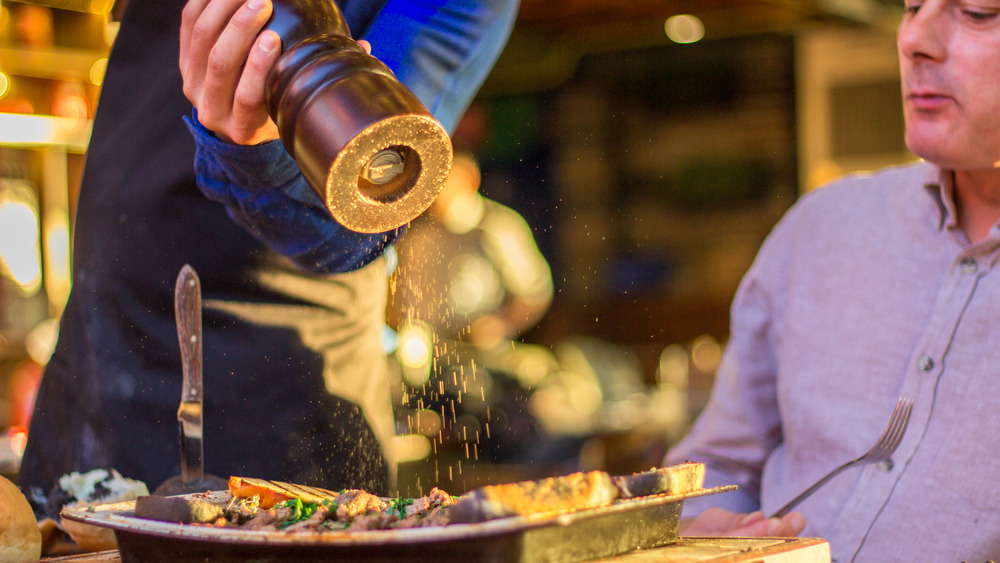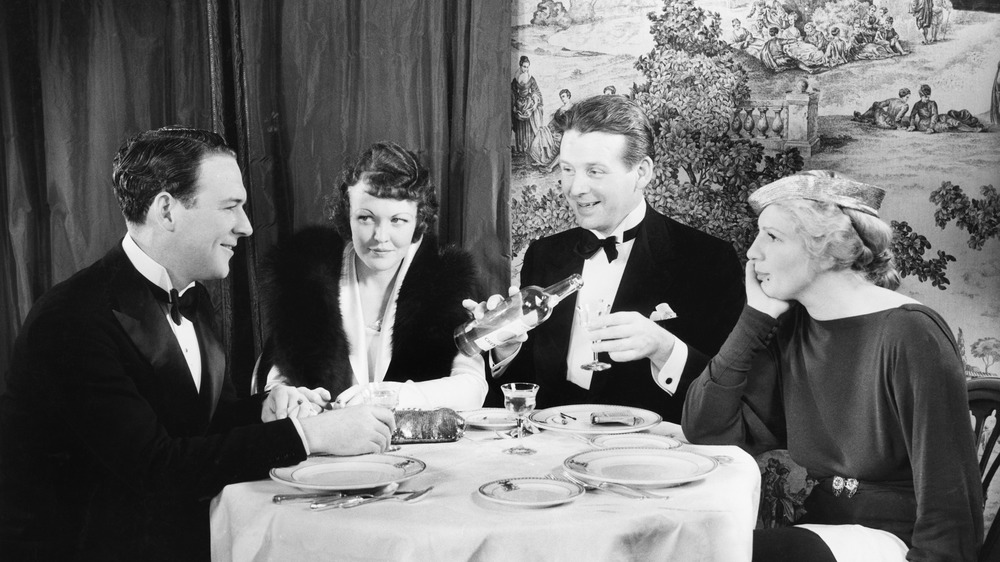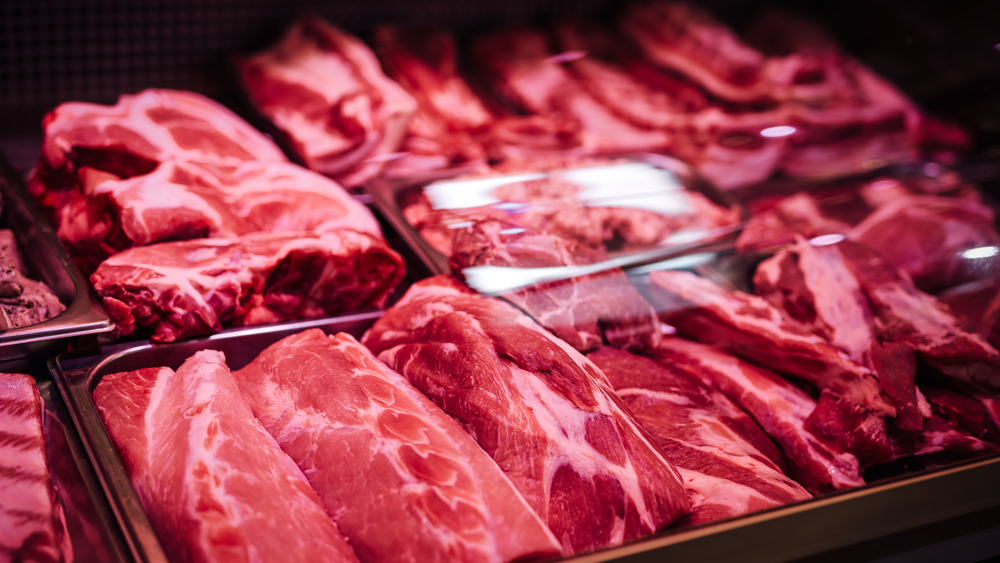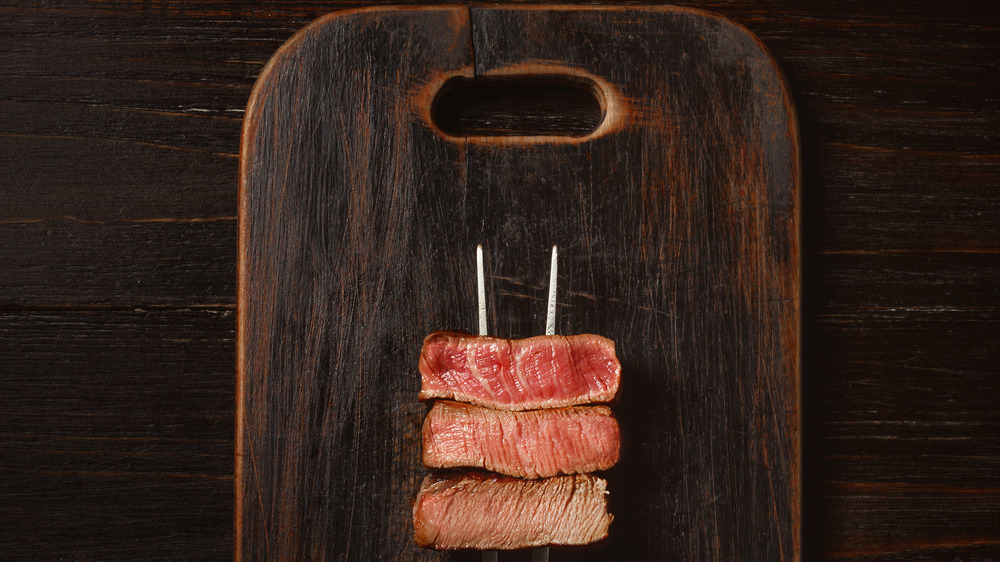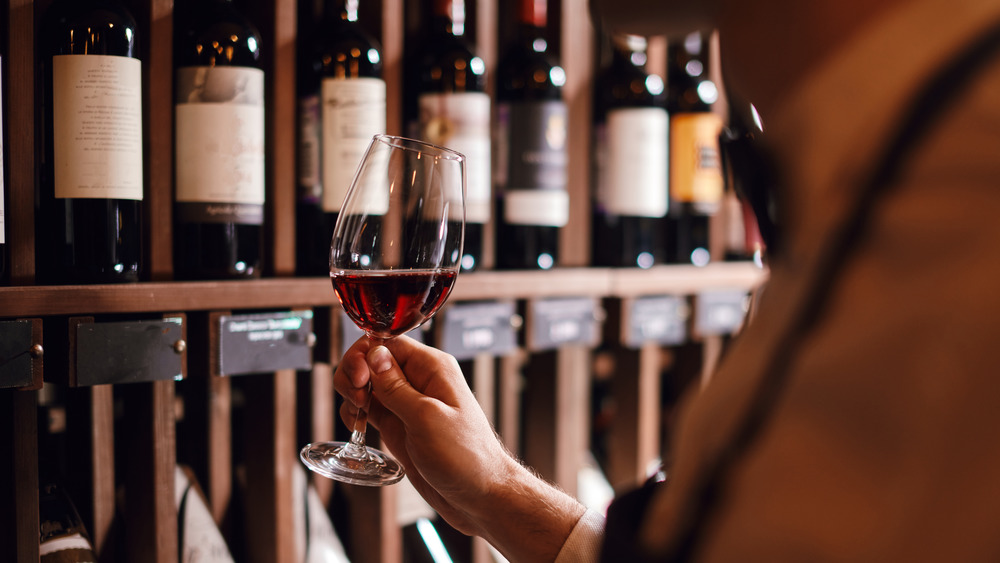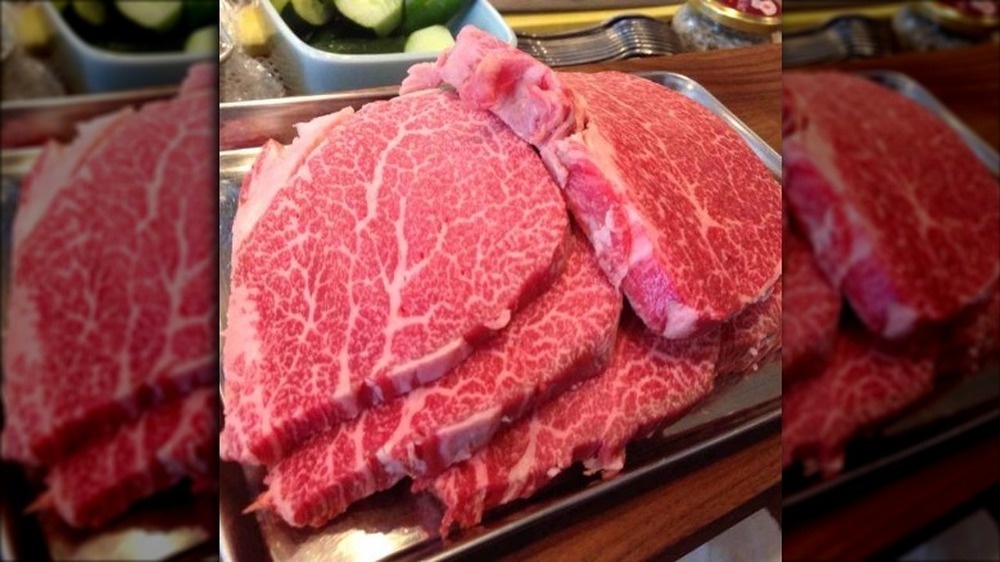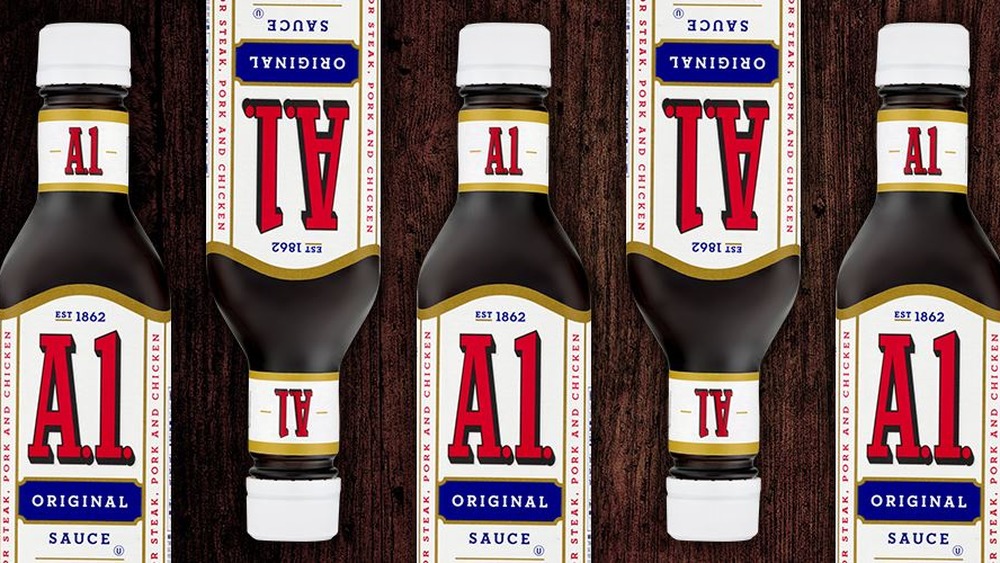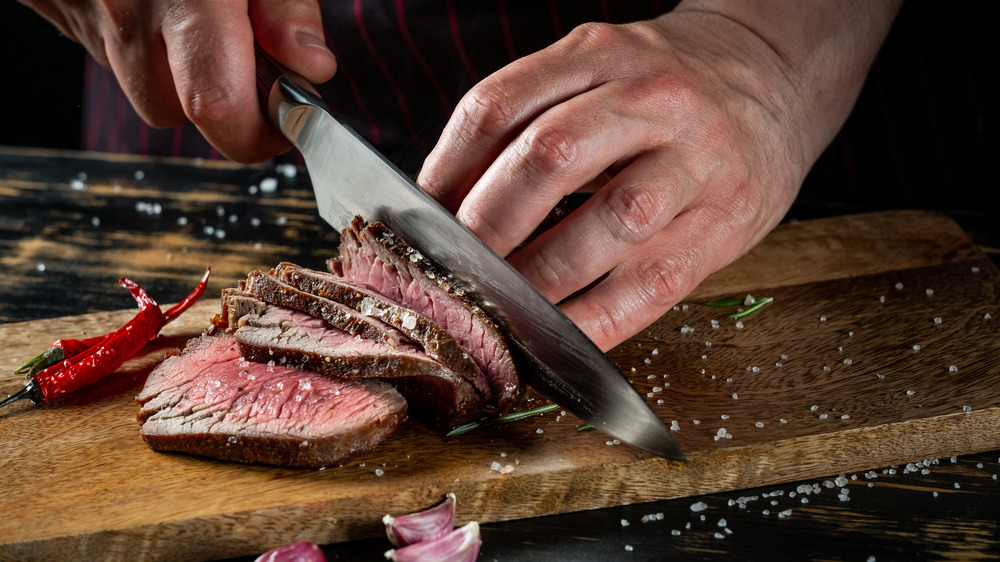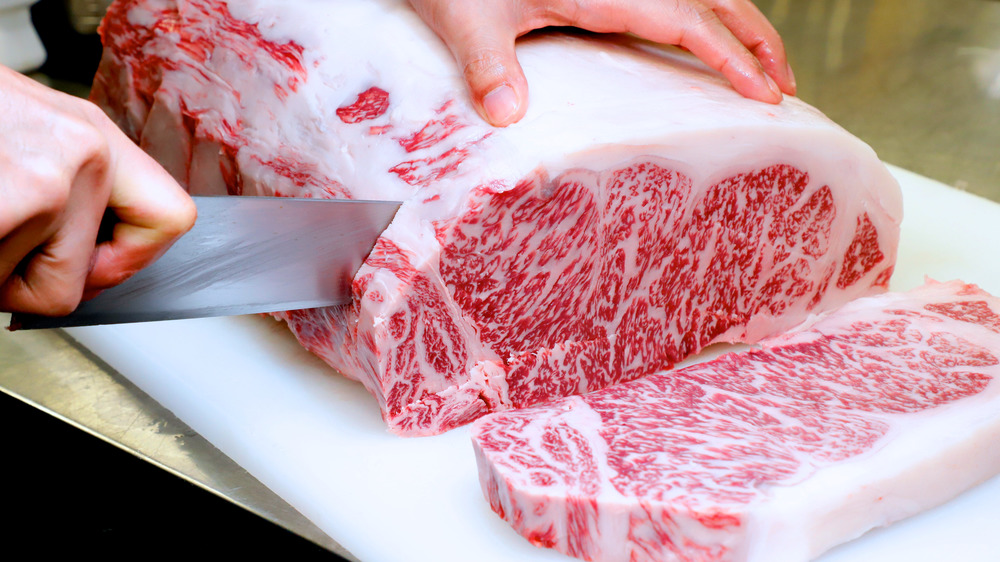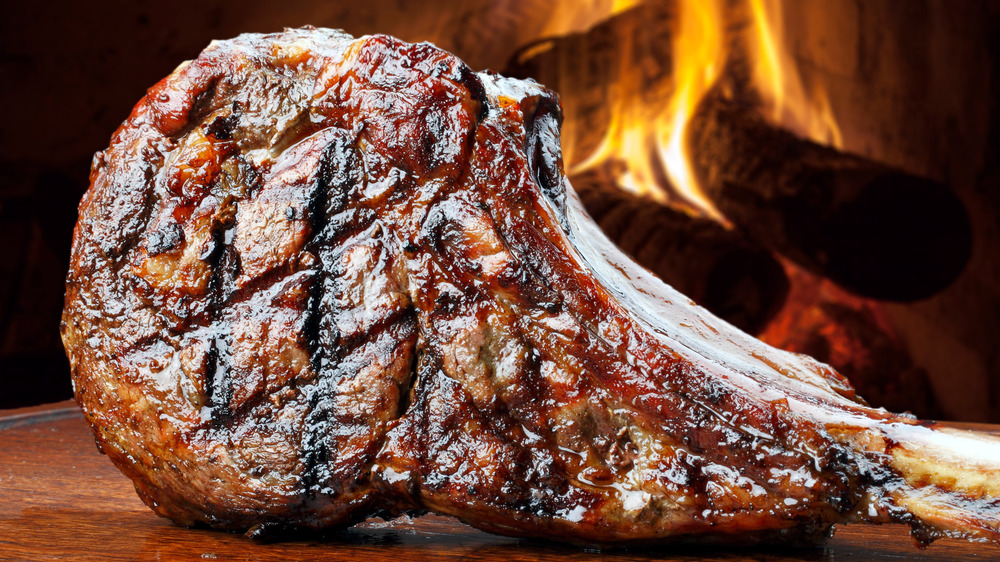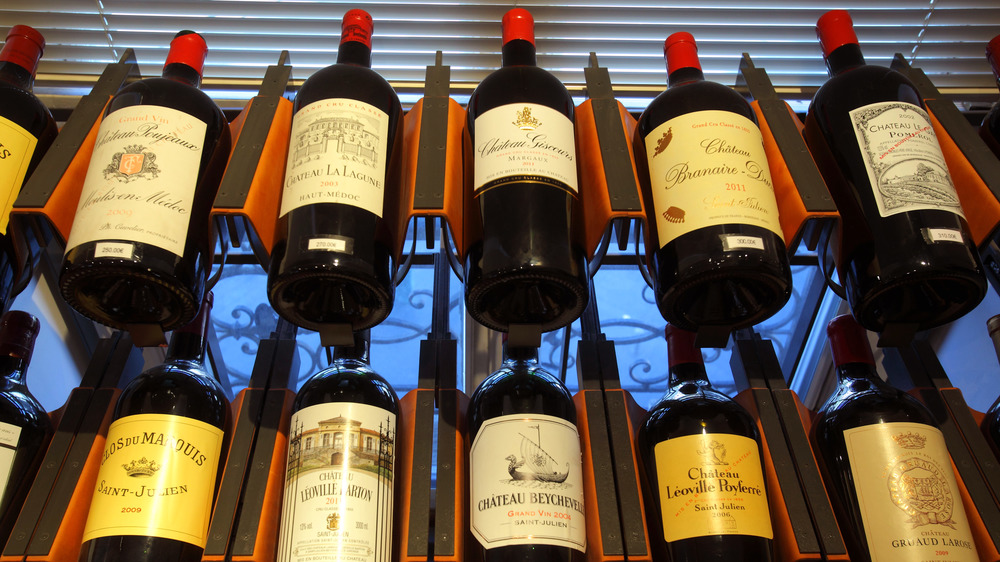Strict Rules You Should Follow At A Steakhouse
Once the domain of cigar-smoking executives on the express train to coronary events, steakhouses have evolved a lot in the past 50 years. Sure, the classic dark dens of prime beef are still around. But their menus, customs, and overall atmosphere feel far more 2020 than a throwback to the '50s. In addition, modern steakhouses with bright lights and even vegan options have popped up too, making what was once a very strict dining experience open to a lot more interpretation.
That being said, eating dinner at a steakhouse is still a special experience, and there are some rules you'll need to follow to realize its full potential. Yes, you can order steak well done. No, you don't need to wear a suit. But to maximize your steakhouse meal, you need to be as much a part of the experience as the beef and the servers. We talked to some experts from the finest steakhouses in the land, and they told us some hard rules to follow when dining in these special restaurants.
Dress the part, but you don't need a jacket for a steakhouse
You can't just roll out of bed like you're going to your freshmen year dining hall and step into a fine steakhouse. Flip flops, shorts, sleeveless shirts, and other beach-worthy attire aren't going to cut it at a steakhouse, says Anibal Macias, General Manager of Michael Mina's Bourbon Steak in Miami. But you don't need to go out and have yourself fitted for a sport coat just because you have a dinner reservation, either.
"Business casual attire is still encouraged at steakhouses today," says Chef Matt King, Vice President of Culinary for Smith and Wollensky, a steakhouse with nine restaurants in cities around America. "But gone are the Mad Men-era days of strict suit and tie protocol."
Bottom line: No, you don't need to wear a suit to go into a steakhouse (though no one's turning you away if you do). But you still need to dress smart and clean. King says wardrobe rules have evolved with the times. Just look like you can afford to eat there, and you'll be okay.
Don't assume the steakhouse chef can do anything you ask
It would surprise absolutely no one if a guest walked into a steakhouse in 2020, looked the waiter straight in the eye, and asked, "So, can the chef make this steak without any meat?" without a hint of irony. In the vegan, gluten-free utopia we now live in, special menu requests are as much a part of going to dinner as asking for a high chair or a table that isn't near the bathroom. But at a high-end steakhouse, guests need to remember that there are limits to what chefs will do.
"It's okay to ask for certain things," says Macias. "But don't be offended if they can't be done by the chef."
These include things like the comical request for a vegan side of beef. But it can also involve things like substitutions in carefully crafted entrees or asking the kitchen to time raw bar and salad orders with a thick cut. Though Bourbon Steak happily cooks steaks however you want them, there are also the odd steakhouses who will not cook your steak well done. Again, this isn't done to offend anyone but rather because chefs have in idea of how they want their dishes enjoyed.
Don't be afraid to ask to inspect your meat before it's served at the steakhouse
You know those steakhouses that look like a big butcher shop when you walk in, with big, red cuts of beef staring back at you from the window like the poor little match girl on a cold winter night? To some, this is a little like window shopping at a department store before going in to buy an outfit. And even if a steakhouse doesn't include raw meat as part of its décor, that doesn't mean you can't ask to see the cut before you order.
"I actually encourage customers to ask to view the steak before it's cooked," Chef Wade Wiestling of Mastro's Steakhouse told First We Feast. "It allows us to show them the quality of the meat."
Remember, dining in a steakhouse is a far more relaxed and lengthy process than, say, Monday night dinner at the neighborhood Applebee's. And typically, your servers are seasoned pros who won't find it even mildly inconvenient to bring out your beef before you order it. The restaurant is happy to showcase its quality, and you should be happy to see if your meat looks like the cut you want.
Know how to order at a steakhouse, and yes, that can mean well-done
If restaurant etiquette were left up to meme-makers, you'd be forcibly removed from a steakhouse for ordering a piece of prime meat above cooked above medium. But good chefs — and owners — know taste is subjective, and if someone is throwing down upwards of $65 for what some might describe as a slightly chewier hockey puck, that's their prerogative. That said, if you like your steaks on the done-er side, order with the confidence befitting someone who commands a table at one of the top steakhouses in the city.
"We serve dry-aged steaks, recommended to be char-broiled medium rare," says Smith and Wollensky's King. "However, if this is not how you enjoy your steak and would like it to be cooked rare or more well done, it's important to share those details with your server so they can relay your preferences to the chef."
Now, might that chef snarl and roll his eyes when he gets that request? Yes. Yes, he might. But that's not your concern. You should also be aware that some restaurants offer special preparations for some steaks, and it may be worth your time to ask your waiter if that's the case. King mentions a "carnivore favorite" that S&W does on classic cuts, medium-rare with extra char. "It will deliver a nice, charred caramelization on the outside, but a warm, red, juice center on the inside," he says.
You can order the cheapest wine, but don't order the 'house wine' at a steakhouse
A good steakhouse will not have a bad wine on the menu, and ordering the cheapest one won't reveal a lack of sophistication. Quite the contrary, it shows a confidence in the sommelier's ability to select quality at all price ranges, something good steakhouses pride themselves on. That said, that same sommelier puts a lot of effort into crafting the steakhouse's wine list, so you should take the time to look it over and order the wine by name. It's not a checkered-table Italian restaurant, so don't just ask for a pat "house red."
"Don't order a house glass of white or red wine, be specific," says Bourbon Steak's Macias. "The wine list might have multiple wines by the glass and nothing designated as a house wine."
The wine list might also have multiple glasses of cabernet, merlot, or other varietals you ask for by name. So, again, take the time to peruse the wines by the glass (or bottle, if you're feeling strong), and order by specific name. It makes you look more knowledgeable — even if you're not — and makes your server's job just a little bit easier.
Spot the difference between quality steak and marketing terms at steakhouses
A lot of words get slapped on steakhouse menus to make the end product sound more appealing. And while you'll almost never find low-quality meat in a fine restaurant, some of those words have specific criteria behind them that aren't always followed. Wagyu, for example, literally could refer to any cow from Japan. But the kind most diners are looking for comes from a specific breed that metabolizes fat in its muscle tissue, creating exceptionally marbled meat, according to an explanation in The Robb Report. It'll usually be accompanied by an A4 or A5 rating (A5 is the highest), but ask your server to see the meat before you order it to ensure it's what you expect.
Same goes for Kobe beef. Kobe is a brand name for a certain type of Wagyu that comes from Kobe, Japan, and according to Crowd Cow, only 21 restaurants in America served it as of 2017. If you see words like "American Kobe," it just means a Japanese cow bred in America and isn't the high-priced delicacy you may believe it to be.
Additionally, Angus is a type of cow, but Certified Angus Beef is a special brand of beef that meets strict quality and marbling standards, which you can peruse on their website. So any Angus steak might be tasty, but without the word "certified," nothing distinguishes it from others.
Do not slather your steak in steak sauce at a steakhouse
Much like the sommelier takes time to hone their craft and prepare a wine list that sparkles from top to bottom, so does the chef spend meticulous effort creating perfect presentations for steak. So dumping an entire bottle of A.1. on top of it is like re-touching the faces on a Picasso because you think the ear's in the wrong place. It's especially insulting if you haven't even tasted the meat yet, since the chef may have marinated or dry-rubbed the steak to give it a signature flavor. And if that signature flavor all of a sudden turns into one crafted by Heinz, what's even the point of dining out?
"For an aged steak, it's almost sacrilegious to put sauce on it because you're missing out on the whole process," chef John Tesar of Knife in Dallas told Thrillist. "American sauces are made to add things to a dish or to cover up meat that isn't as good. Steak sauce became a cover-up and not a complement."
That said, some people are dead-set on having some kind of sauce with their meat. For those guests, most steakhouses offer specialty sauces for a few dollars extra, which are created to complement the meat with delicate flavor profiles. Au poivre, garlic butter, chimichurri, bernaise, and others are far more acceptable alternatives to stuff you can pick up in the condiment aisle.
Don't cut your entire steak at once at a steakhouse
Maybe when you were five, your mom cut up an entire steak into bite-sized pieces for you. This was done a) so you didn't choke, and b) because no five-year-old should be trusted with a knife that can slice cardboard. It was not done, however, because fine cuts of meat are meant to be enjoyed in pre-cut pieces suitable for a kindergartner. If that were the idea, they'd find a way to shape them like dinosaurs.
According to Taste of Home, the correct way to cut a steak at a steakhouse is doing so one bite at a time, with your knife in your right hand and the fork in your left. (Lefties, this is second nature to you. Righties, it might take some practice.) Hold the meat with your left hand while delicately slicing with your right. Lefties, go ahead and put that bite of steak straight in your mouth once it's cut. If you use your right hand, shift the fork over and enjoy from there. Just make sure to remember to place the knife on your plate before you do so — and not errantly on the white-tableclothed table.
Some restaurants serve certain cuts pre-sliced, especially in large cuts made for sharing. The same rules still apply, though, as typically, those slices aren't bite-sized.
Don't chew on the steak bone at a steakhouse
Maybe you're the kind of wing eater who sucks all the meat off the wing and leaves nothing on the plate but bone and drops of buffalo sauce. It's a style, we admit, and while it's perfectly acceptable while pairing poultry with light beers during a marathon football Sunday, it's absolutely unacceptable at a steakhouse when enjoying a bone-in steak, according to Taste of Home.
Some cuts — like giant Tomahawks, for example — offer so much meat on the bone steakhouses pre-cut it for you. In these cases, that bone is for decoration only and NOT part of your meal. Yes, the weight of the bone is factored into the price of the steak, and you might feel like you're paying for decoration. But this is not an excuse to go all Fred Flintstone and start gnawing on the bone at your dinner table. At best, it'll get you some weird looks. At worst, it'll prevent you from ever being invited to a fine steakhouse with your party again. Do yourself a favor, and save it for your dog.
Don't ever spit gristly pieces of meat into your napkin at a steakhouse
If you're into lean cuts of meat like filet mignon and top sirloin, you typically don't get pieces of pure fat on your fork. But with ribeye, New York strips, and other flavor-filled cuts with lots of delicious fat, it's not uncommon to get a piece that's almost impossible to chew.
If you find yourself in this predicament, do not spit the meat into your napkin at a steakhouse. It might be tempting, given you've got a piece of fat in your mouth and a cloth receptacle sitting right there on your lap. But it's a big no-no. "If you bite into something difficult to chew (like a piece of meat or gristle), you don't spit it into your cloth napkin," etiquette expert Jacqueline Whitmore told Forbes during an interview on napkin dos and don'ts.
"When no one is looking, you discreetly take it out with your two fingers and put it on the edge of your plate." If you'd rather not have your food scraps staring your table mates in the face, you can also ask the waiter for another napkin. Just make sure that one stays out of sight and never on your plate.
Don't go straight for the most expensive steak on the menu at a steakhouse
Steak, like everything else in the world of food, is subjective. And though the prices at a steakhouse aren't cheap, the price of the cut won't neccesarily correlate with what you like. For example, the menu at Bourbon Steak is topped by an 20-ounce Cowboy Ribeye clocking in at $75. Not only is this a massive cut of meat, it's also a highly-marbled cut, which means it's got lots of fat and loads of flavor. And if you're into that, then ordering off the top of the menu may be the move. That said, if you're into leaner, more tender cuts, something like a filet mignon might be for you. And that one runs only $52, the second-least-expensive cut on the menu.
This rings even truer when visiting a steakhouse with items like wagyu beef on the menu, which are typically sold by the ounce and are much more expensive than traditional cuts. If you like extra tender, fattier beef, wagyu might be worth the price for you. But if you're into more traditional preparations and like your steak with a little heft, spending the extra for wagyu will just be a waste.
If you've got a big group at a steakhouse, order a magnum of wine
At first glance, boasting a bottle of wine larger than your torso might seem a bit tacky. An obvious, "Hey, look at me, I can afford enough wine to give Andre the Giant a pretty good buzz" statement that's done solely for the sake of appearances. And while, yes, ordering a magnum of Ace of Spades for your table at the club might be a little show-offy, a magnum at a steakhouse can actually be an economic move if you've got a large party. And it also makes you look cool in the process.
A typical magnum contains around ten glasses of wine, according to Masterclass. And if your party of four is planning to order two to three glasses each, you're actually going to save money. The more people you have, the more economical a magnum can be. Not that you're going out to a fine steakhouse to be thrifty, but if you can all agree on one type of wine, a magnum makes sense. It also adds a special occasion aesthetic to your meal, ideal for giving everyone who bailed on dinner a serious sense of FOMO.
Above all else, remember to relax when you go to a steakhouse
You're not dropping a Kia payment on dinner to stress out. Yes, you want to look the part and act like a civilized human when dining in a steakhouse, but nothing about the experience should be stressful aside from the tension on your belt after dessert.
"Guests should throw out any preconceived notions or concerns about outdated Emily Post handbook etiquette and relax," says Smith and Wollensky's Chef King. "So counting prongs on cutlery to determine which fork is traditionally for salad and which is for dessert isn't on the menu."
At its core, dinner at a steakhouse is just a meal, meant to be enjoyed among friends, with little concern for cost, calories, or work the next day. While these rules will help optimize the experience for both you and the restaurant, don't spend the whole meal checking off your mental list. Relaxing and enjoying yourself may be last on our list, but it's really the most important rule. Well, aside from never asking for a bottle of steak sauce.
